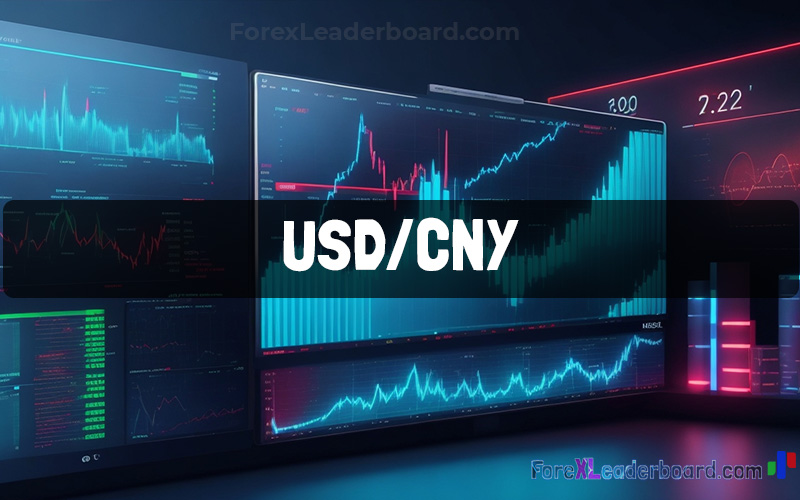The USD/CNY currency pair represents the value of the United States dollar (USD) relative to the Chinese yuan renminbi (CNY). It is an important forex pair for traders to understand, especially given China’s significance in the global economy. This article will provide an in-depth look at the USD/CNY, including factors that impact its price movements, how to trade it, and strategies for profiting from this exotic currency pair.
Introduction to USD/CNY
The USD/CNY depicts the exchange rate between the U.S. dollar and the Chinese yuan. It indicates how many Chinese yuan are needed to buy one U.S. dollar. The US dollar serves as the base currency while the Chinese yuan is the quote currency.
The code for the pair is USD/CNY but it may also be shown as USDCNY or CNH in some platforms. CNY refers to yuan traded within mainland China, while CNH is yuan traded offshore, mainly in Hong Kong.
This forex pair is influenced by economic and political factors in China and the United States. As China has the second largest economy globally, sentiment towards Chinese currency can significantly impact the USD/CNY exchange rate.
Brief History of USD/CNY Trading
China first introduced the yuan in 1948. For decades it was pegged to the USD at a fixed rate of 2.46 CNY per 1 USD. This ended in 2005 when China revalued the CNY and adopted a “managed floating exchange rate” system based on market supply and demand.
In 2015, the People’s Bank of China changed the CNY fixing mechanism to consider the previous day’s closing rate. More flexibility was introduced in 2017 to allow market forces to play a greater role.
Although gradually liberalizing, China still maintains tight control over the CNY through fixing, intervention, and capital controls. USD/CNY is not a free-floating currency pair.
USD/CNY Pricing Factors
Many complex political and economic circumstances between the United States and China impact the USD/CNY exchange rate. Here are some of the most significant factors:
China’s Economy and Trade
With China being the world’s largest exporter, its economic performance significantly impacts global trade and the USD/CNY rate. Weaker Chinese data like lower GDP growth or manufacturing declines usually weaken the yuan. Strong economic numbers have the opposite effect.
Shifts in China’s trade relationships, especially with the U.S., also influence USD/CNY pricing. Increased Sino-U.S. trade tensions tend to weaken CNY as global investors sell the yuan due to uncertainty.
Monetary Policy Divergence
When China’s central bank cuts interest rates to boost growth while the U.S. Federal Reserve raises rates to control inflation, monetary policies are diverging. This policy divergence applies depreciation pressure on CNY relative to USD.
Capital Flows
China imposes capital controls to manage outflows and prevent devaluation of the yuan. When controls relax, it can trigger CNY selling by global investors leading to yuan weakness. Sudden changes in capital flows related to policy shifts impact the USD/CNY as well.
Dollar Strength or Weakness
As a pegged currency, the CNY tends to move in line with the dollar. Strong U.S. economic data or hawkish Fed policy often leads to concurrent dollar and yuan strength. USD weakness has the opposite effect on the pair.
Risk Sentiment
When market risk aversion increases, traders sell riskier assets including emerging market currencies like the yuan. USD/CNY can rise during bouts of geopolitical tensions or financial market volatility as investors flock to safe havens.
Technical Levels
Like other currency pairs, the USD/CNY exhibits long-term technical trends and respects key support and resistance levels derived from historical pricing. Staying abreast of technical formations is crucial for successful trading.
Unique Attributes of Trading USD/CNY
While straightforward in some ways, trading the USD/CNY currency pair poses some unique challenges:
Heavily Managed Rate
As mentioned, China’s central bank fixes the yuan daily based on a basket of currencies. This means USD/CNY does not float freely based on open market forces. China maintains tight control through frequent intervention.
Low Liquidity
Far less USD/CNY volume is traded compared to major pairs like EUR/USD. The lower liquidity increases slippage and widens bid-ask spreads. Large orders can move rates more severely with less underlying volume.
Daily Fixing
The USD/CNY has a daily fixing rate set by the People’s Bank of China based on the previous day’s close. This fixing causes exchange rates to gap higher or lower when trading resumes. It adds short-term volatility around the time of the fix.
Limited Market Hours
Onshore USD/CNY trading in mainland China operates between 1:15am to 9:30am GMT each day. The offshore CNH market has longer hours but still shuts Friday night to Sunday evening. Limited hours can increase weekend gapping.
Restricted Access
Foreign exchange controls in China limit access to onshore markets. Retail traders outside mainland China trade the offshore CNH instead, althoughliquidity differences exist. Institutional traders have more options to access the onshore yuan directly.
These attributes make the USD/CNY pair more susceptible to short-term volatility spikes and government intervention compared to free-floating pairs. Having a solid understanding of China’s policy objectives is key.
Trading the USD/CNY
USD/CNY offers unique trading opportunities but requires an appropriate strategy. Here are some tips:
Follow China’s Economy Closely
Stay updated on high-impact news like China GDP, trade data, manufacturing PMIs, fiscal policy changes, and reform announcements. These economic releases move the yuan as traders react to changing outlooks.
Monitor USD Trends
Watch dollar strength/weakness through the DXY index or USD crosses like EUR/USD. USD/CNY often follows broad dollar moves on a related timeframe due to the fixed peg.
Consider Intervention Risks
With China managing the yuan, sudden rate changes from PBOC intervention are likely. This can rapidly reverse profitable positions. Consider tight stops and watch for signs of intervention.
Use Range Trading Strategies
USD/CNY frequently oscillates within defined ranges rather than exhibiting sustained trends. Range-bound tactics using double tops, channel breakouts, and swing high/lows can work well.
Watch for Divergence
When USD/CNY diverges from normal USD correlations it often precedes bigger moves, presenting trading opportunities as the divergence corrects.
Manage Liquidity Differences
Use prudent position sizing, limit orders, and wider stops to account for lower USD/CNY liquidity. Avoid trading around the fix when spreads widen significantly.
Know Your Trading Tools
Since direct onshore USD/CNY trading is restricted, ensure brokers provide sufficient CNH or NDF market access. Use trading platforms with comprehensive CNY pricing data.
With the right approach, the nuances of the USD/CNY market can lead to trading success. But this exotic pair still carries higher risks than major currency pairs. Proper analysis and risk management are essential.
Key Strategies for Trading USD/CNY
Several strategies allow traders to profit from USD/CNY movements and volatility:
Range Trading
With USD/CNY often oscillating between support and resistance rather than trending, range trading tactics work well. Watch key levels like daily fixes, 50/100-day moving averages, and chart highs/lows. Trading the range extremes offers an opportunity.
Breakout/Breakdown Trading
Eventually ranges break with heavier one-directional movement. Trade breakouts above range resistance or breakdowns below range support. Manage positions on a breakout failure with stop loss above/below the opposite side of the range.
Trading Macroeconomic News
Scheduled news events like China GDP, U.S. NFPs, inflation data, and trade figures create USD/CNY volatility. Build positions before the data based on forecast expectations, then actively manage around the announcement.
Trading Intervention
China’s central bank occasionally intervenes to adjust the yuan if USD/CNY strays too far. Watch for signs like unexplained gaps or accelerating moves. Intervention trading is risky but can be rewarding if timed well.
Hedging USD Exposure
Chinese companies with U.S. dollar payments can hedge USD exposure by trading USD/CNY. Strategies include closely tracking exchange rates for order entry/exits and incorporating FX options.
Carry Trades
When CNY funding costs are lower than USD, traders borrow low-yield yuan to buy the higher-yielding dollar. The interest rate differential delivers extra profit on the exchange rate move.
Proper application of strategies allows traders to navigate the nuances of the USD/CNY pair and extract profits from this unique market.
Managing Risk with USD/CNY
Several risks require consideration when trading the Chinese yuan:
Intervention Risks
Sudden PBOC intervention to alter the yuan fixing can rapidly change pricing and stop out positions. Stay alert for signs of intervention like volatile gaps or accelerating moves in thin liquidity.
Wide Spreads/Slippage
Lower USD/CNY liquidity leads to wider bid/ask spreads, increasing transaction costs. Rapid orders can slip and fill at worse rates compared to expected pricing. Use prudent position sizing and limit orders to manage.
Volatility Around the Fixing
Each day China announces its CNY fixing rate against the USD based on the previous close. Gapping at the open is common after the fixing. Avoid holding positions across the fixing announcement if possible.
Restricted Market Hours
Onshore CNY trading shuts down each afternoon local time. And all CNY markets close from Friday night through Sunday. The limited hours increase volatility from weekend gaps on Monday opens.
Geopolitical Tensions
Rising tensions between China and Western nations occasionally roil markets. Events like new U.S. tariffs or sanctions can spark an exodus from the yuan. Monitor geopolitics closely when trading USD/CNY.
While the USD/CNY has risks to know, proper precautions allow traders to successfully navigate this unique currency pair.
Example USD/CNY Trades
To demonstrate trading strategies, here are two example USD/CNY trades:
Range Trading
USD/CNY is testing the lower boundary of its 12-month range at 6.35. You go long at 6.3450, believing prices will bounce off support and revert back upward as usual within the range. Stops are placed below the range bottom at 6.3350 to limit risk if the range breaks down. Profit target is the 6.4550 swing high.
Trading Divergence
USD/CNY rises to 6.50 despite broad USD weakness. You notice the unusual divergence where USD/CNY is not following its normal correlation. Expecting it to correct, you short USD/CNY at 6.4850 targeting the 20-day moving average near 6.4250 based on the divergence strategy. Stops are placed above the recent swing high at 6.5150.
These examples demonstrate how range trading and divergence trading approaches can identify strategic entry and exit points in the dollar-yuan pair.
Key Takeaways on Trading USD/CNY
Here are some key takeaways to remember when trading the Chinese yuan:
- USD/CNY pricing relies heavily on China’s economic outlook and monetary policy. Stay updated on high-impact news.
- Watch broad dollar moves closely as USD/CNY often correlates strongly to dollar strength/weakness.
- Manage intervention risks by using tight stops and watching for signs the PBOC is actively managing the rate.
- Range trading tactics work well as USD/CNY often oscillates between technical levels rather than trending persistently.
- Monitor for divergence between USD/CNY and normal dollar correlations to spot reversals early.
- Use proper trade size for the lower liquidity and wider spreads seen in USD/CNY markets.
Understanding the unique attributes of the USD/CNY helps traders profit from this intriguing currency pair. Apply the strategies discussed here to make this exotic forex market a winning part of your portfolio.
Conclusion
The dollar-yuan currency pair USD/CNY represents an important emerging market forex cross. China’s heavily managed exchange rate policy and global economic significance impart unique attributes to trading the pair.
By studying the pricing drivers, trading dynamics, and risk factors of the USD/CNY, traders can take informed positions and employ strategies to extract profits. Although the managed yuan introduces certain challenges, a thoughtful approach allows experienced forex traders to consistently earn from exchange rate fluctuations and volatility.
As China continues embracing market forces in the future evolution of the yuan, the dimensions of USD/CNY trading will change over time as well. Staying current on the latest forex policies and reforms in China is crucial. But for now, apply the tips outlined here to make USD/CNY a key component of your trading strategy.

